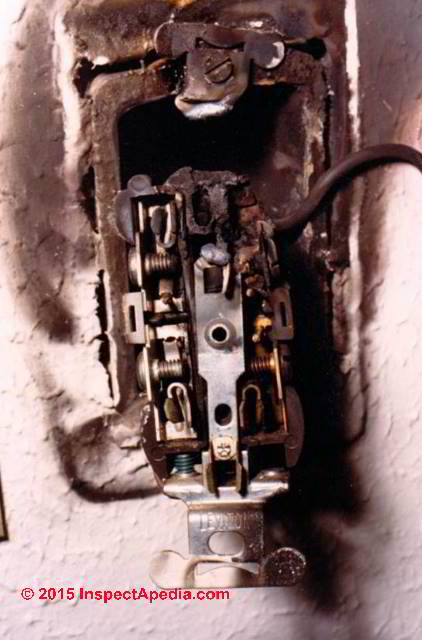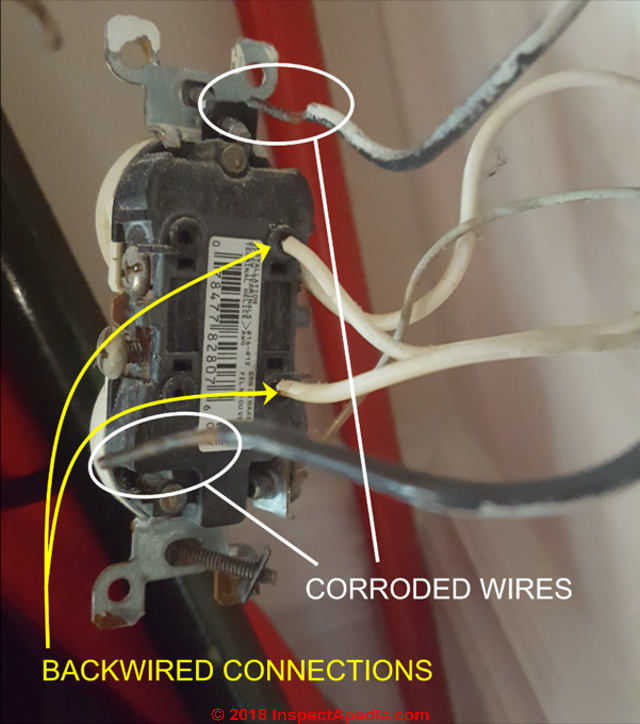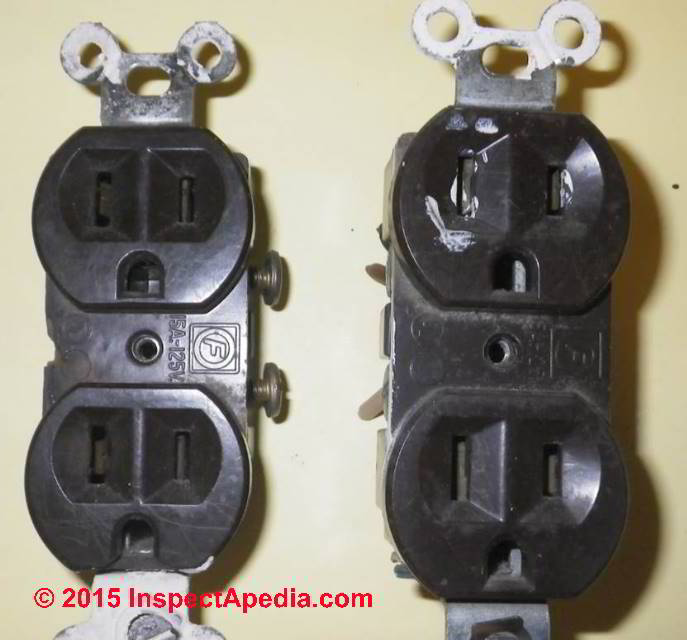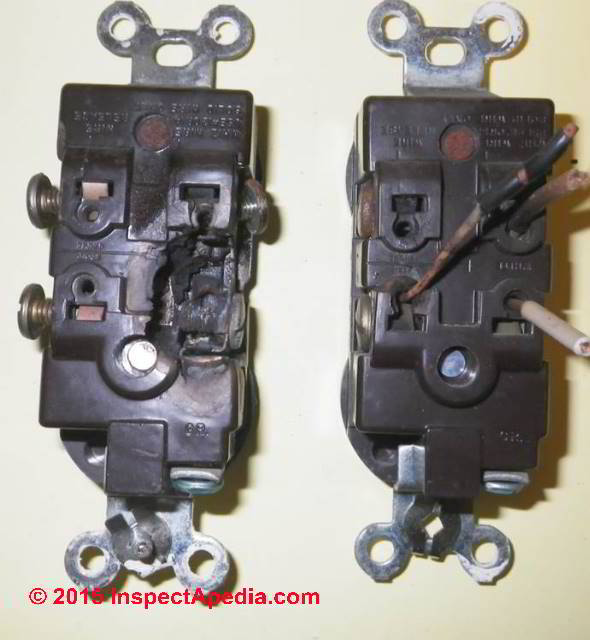 Backwired Electrical Receptacle & Switch Failures
Backwired Electrical Receptacle & Switch Failures
Photos of overheated, failed, burned, shorted back-wired electrical devices
- POST a QUESTION or COMMENT back-wired electrical receptacle or switch failures
Back wired electrical receptacle failures:
Photos of failures occurring at or within back-wired electrical receptacles and switches.
At page top we illustrate a #14 solid copper wire being pushed into the backwire opening of a common electrical receptacle. The wire has not been pushed fully into the connection as I wanted to show the diameter of the wire entering the push-in connector opening.
This article series illustrates and explains possible electrical failures and fire risk when using the push-in rear connectors on some back-wired electrical devices such as receptacles and switches.
InspectAPedia tolerates no conflicts of interest. We have no relationship with advertisers, products, or services discussed at this website.
- Daniel Friedman, Publisher/Editor/Author - See WHO ARE WE?
Photo-Examples of Failures in Back-Wired Electrical Receptacles Illustrate the Failure Condition

Using the back-wire or push-in type connection points on an electrical receptacle or switch may be just fine, or it may not be reliable nor safe, depending on the age and type of back-wire connector provided.
This article series explains receptacle types, receptacle grounding, connecting wires to the right receptacle terminal screws, electrical wire size, electrical wire color codes, and special receptacles for un-grounded circuits.
The photograph at above-left illustrates a failure of a push-in type back-wired electrical receptacle.
A fault occurred between the live contact assembly and the grounded receptacle mounting strap (center of the photo) causing fire ignition.
The photograph shows the end result of a long-term and multi-step process, where the overheating push-in wire termination caused carbonization of the bakelite around it, which then faulted (probably when it absorbed moisture from the atmosphere during long "off" periods). - J. Aronstein to D Friedman, private email, 10/29/2015
Dr. Aronstein reports having encountered this failure multiple times and in each occasion the receptacle had been push-in backwired.
Low Contact Force is a Key Performance Difference Between Push-In Wire Connections & Clamp or Screw Terminals on Receptacles & Switches
Low contact force between the wire and the receptacle connector where spring-type push-in backwired terminals are used on receptacles is probably the most significant reason that these connections can be expected to deteriorate over many years.
The small contact area afforded by these connectors, documented at RECEPTACLE WIRE-TO-CONNECTOR CONTACT AREA SIZES may increase that risk.
Watch out:
The key performance difference between the push-in and clamp or screw terminals is the rate of deterioration of the electrical connection. The condition of the connection and connector and rate of deterioration become important over a time frame of years in the typical installed environments (which are highly variable).
There may also be considerable variation in the conditions among the 30 or more push-in wire connections in a typical string of receptacles on each receptacle circuit in a home. Those receptacles that are subject to more frequent use and those subject to heavier loads get more disturbance over time.
A push-in spring connection, inherently much weaker than a screw or clamp type connection, will suffer more disturbance, movement, and weakening than the stronger connectors as the receptacle is used, possibly increasing the risk of a subsequent failure.
The time scale of this deterioration usually is years and decades. This means that the fact that electrical failures or problems with these devices were not seen early in their installed life is no assurance whatsoever that the connectors and devices in an older home will continue to remain safe and reliable in the future.
In other words, the probability of a failure, overheating, and a possible fire and loss increase over time. In a 40 or 50 year old home, push-in wired electrical connections on the home's electrical system are not to be trusted. - J. Aronstein Op. Cit.
Below are front and rear view of another push-in type back-wired electrical receptacle failure. These photographs are provided courtesy Jess Aronstein.
and
- Aronstein, Jess,[Personal communication, J.A. to the editor (Daniel Friedman)], 25 October 2015. Dr. Jess Aronstein, protune@aol.com is a research consultant and an electrical engineer in Schenectady, NY. Dr. Aronstein provides forensic engineering services and independent laboratory testing for various agencies. Dr. Aronstein has published widely on and has designed and conducted tests on aluminum wiring failures, Federal Pacific Stab-Lok electrical equipment, and numerous electrical products and hazards.
See ALUMINUM WIRING BIBLIOGRAPHY and FPE HAZARD ARTICLES, STUDIES
and also BACK-WIRED ELECTRICAL DEVICES for examples. - RECEPTACLE WIRE-TO-CONNECTOR CONTACT AREA SIZES - measurements & calculations of the contact area between an electrical wire and the connecting device on an electrical receptacle or switch explain differences between push-in type backwire connectors, compression plate connectors, and binding head screw connectors, all of which are found on many electrical receptacles and switches.
- Also seeReferences or Citations
...
Reader Comments, Questions & Answers About The Article Above
Below you will find questions and answers previously posted on this page at its page bottom reader comment box.
Reader Q&A - also see RECOMMENDED ARTICLES & FAQs
Reader Field Failure Report: power lost at beach-front home
 I read your article on BACK-WIRED ELECTRICAL DEVICES and you indicated an interest in field examples of failures.
I read your article on BACK-WIRED ELECTRICAL DEVICES and you indicated an interest in field examples of failures.
We recently stayed at a beach house owned by some friends, and I replaced some failing dimmer switches for them as a favor. I noticed consistent backwiring on these devices to feed downstream loads.
Then on the final day of our stay, there was an electrical failure in a circuit that I had not worked on.
What I discovered when I chased down the fault was very concerning.
The incoming black and neutral were screw connected to the first receptacle in a long circuit, and there were two circuits being fed downstream from the backwire connections on the receptacle.
These failed with evidence of arcing on the wires.
Attached is a paper (with pictures) [now on-line as edited at BACKWIRED RECEPTACLE FAILURE REPORT ] that I put together to help my non electrical friends understand the failure and its potential implications for the safety of their property.
As you will see, I strongly encouraged them to have all of the devices rewired to eliminate backwired connections and connections that use devices as terminal blocks for downstream current flow.
They plan to have this done as soon as possible.
Apparently, there was a house in the same neighborhood that burned to the ground recently and the cause was attributed to an electrical fault (I don’t know that the fault was a backwiring issue, but it would not surprise me if the same electrician did other properties in the neighborhood).
These are multimillion dollar Atlantic beach front properties… not the kind of places you expect such lazy electrical work.
It makes me angry because this house has a zillion receptacles, switches, dimmers and appliances. Some electrician made a pot full of money doing this property and should be ashamed for his laziness.
Anyway, I hope this is useful to your cause. - Anonymous by private email 2018/07/24
Reader comment: field report of backwired device failures
A very large number of my service calls are due to push in receptacles. I have had burn outs as shown above, but usually the result is an open circuit, often causing lack of current in down line receptacles.
I always replace with side clamp wire receptacles and sometimes home owners or landlords have had me remove and replace all of them in the home. 2017/03/20 J W said:
Reply:
JW
Thank you for your important comment. This topic has been a thorn in the side of safe electrical wiring for some time. It is particularly useful (and compelling) to have feed-back from people who have both expertise and field experience with electrical wiring failures.
If you come across a burned, failed backwired device and can send me photos those would be most helpful. My email is at the page top or bottom CONTACT link.
...
Continue reading at BACK-WIRED ELECTRICAL DEVICES - topic home, or select a topic from the closely-related articles below, or see the complete ARTICLE INDEX.
Or see these
Recommended Articles
- BACK-WIRED ELECTRICAL DEVICES - home
- BACKWIRED RECEPTACLE FAILURE PHOTOS
- BACKWIRED RECEPTACLE FAILURE REPORT
- BACK-WIRING FAQs for RECPTACLES & SWITCHES
- RECEPTACLE WIRE-TO-CONNECTOR CONTACT AREA SIZES
- WIRE-TO-CONNECTOR FORCE COMPARISONS
- WIRE-TO-CONNECTOR PERFORMANCE SUMMARY
Suggested citation for this web page
BACKWIRED RECEPTACLE FAILURE PHOTOS at InspectApedia.com - online encyclopedia of building & environmental inspection, testing, diagnosis, repair, & problem prevention advice.
Or see this
INDEX to RELATED ARTICLES: ARTICLE INDEX to ELECTRICAL INSPECTION & TESTING
Or use the SEARCH BOX found below to Ask a Question or Search InspectApedia
Ask a Question or Search InspectApedia
Questions & answers or comments about how to install and wire electrical outlets or receptacles in buildings.
Try the search box just below, or if you prefer, post a question or comment in the Comments box below and we will respond promptly.
Search the InspectApedia website
Note: appearance of your Comment below may be delayed: if your comment contains an image, photograph, web link, or text that looks to the software as if it might be a web link, your posting will appear after it has been approved by a moderator. Apologies for the delay.
Only one image can be added per comment but you can post as many comments, and therefore images, as you like.
You will not receive a notification when a response to your question has been posted.
Please bookmark this page to make it easy for you to check back for our response.
IF above you see "Comment Form is loading comments..." then COMMENT BOX - countable.ca / bawkbox.com IS NOT WORKING.
In any case you are welcome to send an email directly to us at InspectApedia.com at editor@inspectApedia.com
We'll reply to you directly. Please help us help you by noting, in your email, the URL of the InspectApedia page where you wanted to comment.
Citations & References
In addition to any citations in the article above, a full list is available on request.
- Timothy Hemm has provided photographs of various electrical defects used at the InspectAPedia TM Website. Mr. Hemm is a professional electrical inspector in Yucala, CA.
- [3] NFPA - the National Fire Protection Association can be found online at www.nfpa.org
- [4] The NEC National Electrical Code (ISBN 978-0877657903) - NFPA might provide Online Access but you'll need to sign in as a professional or as a visitor)
- US NEC Free Access: See up.codes at this link: https://up.codes/code/nfpa-70-national-electrical-code-2020
- [5] Special thanks to our reader Steve who pointed out prior errors in our illustrations.
- [6] Simpson Strong-Tie, "Code Compliant Repair and Protection Guide for the Installation of Utilities in Wood Frame Construction", web search 5/21/12, original source strongtie.com/ftp/fliers/F-REPRPROTECT09.pdf, [copy on file as /Structures/Framing/Simpson_Framing_Protectors.pdf ]. "The information in this guide is a summary of requirements from the 2003, 2006 and 2009 International Residential Code (IRC), International Building Code (IBC), International Plumbing Code (IPC), International Mechanical Code (IMC), 2006 Uniform Plumbing Code (UPC) and the 2005 National Electrical Code."
- "Electrical System Inspection Basics," Richard C. Wolcott, ASHI 8th Annual Education Conference, Boston 1985.
- "Simplified Electrical Wiring," Sears, Roebuck and Co., 15705 (F5428) Rev. 4-77 1977 [Lots of sketches of older-type service panels.]
- "How to plan and install electric wiring for homes, farms, garages, shops," Montgomery Ward Co., 83-850.
- "Simplified Electrical Wiring," Sears, Roebuck and Co., 15705 (F5428) Rev. 4-77 1977 [Lots of sketches of older-type service panels.]
- "Home Wiring Inspection," Roswell W. Ard, Rodale's New Shelter, July/August, 1985 p. 35-40.
- "Evaluating Wiring in Older Minnesota Homes," Agricultural Extension Service, University of Minnesota, St. Paul, Minnesota 55108.
- "Electrical Systems," A Training Manual for Home Inspectors, Alfred L. Alk, American Society of Home Inspectors (ASHI), 1987, available from ASHI. [DF NOTE: I do NOT recommend this obsolete publication, though it was cited in the original Journal article as it contains unsafe inaccuracies]
- "Basic Housing Inspection," US DHEW, S352.75 U48, p.144, out of print, but is available in most state libraries.
- In addition to citations & references found in this article, see the research citations given at the end of the related articles found at our suggested
CONTINUE READING or RECOMMENDED ARTICLES.
- Carson, Dunlop & Associates Ltd., 120 Carlton Street Suite 407, Toronto ON M5A 4K2. Tel: (416) 964-9415 1-800-268-7070 Email: info@carsondunlop.com. Alan Carson is a past president of ASHI, the American Society of Home Inspectors.
Thanks to Alan Carson and Bob Dunlop, for permission for InspectAPedia to use text excerpts from The HOME REFERENCE BOOK - the Encyclopedia of Homes and to use illustrations from The ILLUSTRATED HOME .
Carson Dunlop Associates provides extensive home inspection education and report writing material. In gratitude we provide links to tsome Carson Dunlop Associates products and services.



